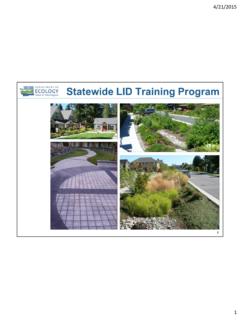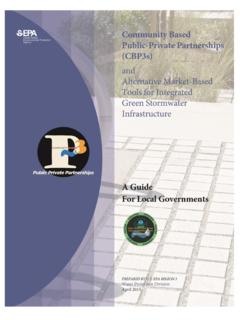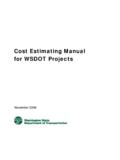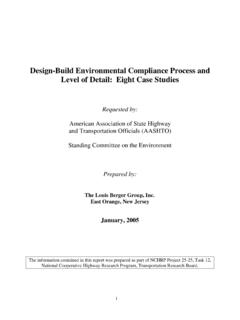Transcription of Module 3.3 Intermediate Design-Permeable …
1 1/17/2017112 INSTRUCTORSC urtis HinmanSenior Scientist Key project experience: Research specialist in the performance and design of LID practices. CHRIS WEBB, PELEED FELLOWA ssociate Engineer Key project experience: permeable pavement, bioretention, rainwater harvesting3introductionpermeable pavement basicscommon siting, design and constructiondesign and construction by pavement typeAGENDA21345wrap-up1/17/201724 LOGISTICSSCHEDULE 8 hour trainingLunch on your own 60 minute site visitOTHER LOGISTICS Restrooms Food Turn off cell phones Sign in and sign out5 LEARNING OBJECTIVES1. Gain an Intermediate level knowledge necessary for proper entry level design and implementation of permeable pavement systems in residential and commercial settings (new and retrofit).2. Learn skills necessary for basic site assessment and locating permeable pavement areas in residential and commercial Learn practical skills necessary for construction of basic permeable pavement systems.
2 6 PROGRAM OVERVIEW 2012: Public and private partners engage state legislature to fund program June 2012: LID Training Steering Committee convened 2012 2013: Washington State LID Training Plan developed: background 2014: Training program built from state LID Training Plan1/17/201737 PROGRAM OVERVIEW Implement first phase of trainings (September 2014 through May 2015) 64 trainings offered in first phase Three levels: Introductory, Intermediate , and Advanced Train the Trainer program for service providers and LID topic experts Future funding LEADADDITIONAL TRAINING SUPPORTTEAMCORE TEAM9 Introduction toLID for Eastern WashingtonINTRODUCTORYINTERMEDIATEADVANC EDTRAIN THE TRAINERSS ervice ProvidersIntroduction toLID for Inspection & Maintenance StaffIntroduction toLID for Developers & Contractors: Make Money be GreenIntermediate LID design : Rainwater Collection Systems & Vegetated RoofsIntermediate LID NPDES Phase I & II RequirementsIntermediate LID design : permeable PavementIntermediate LID design : Hydrologic ModellingAdvanced Topics in LID design :BioretentionAdvanced Topics in LID design : permeable PavementAdvanced Topics in LID design :Hydrologic ModelingAdvanced Topics in LID design : Site Assessment, Planning & LayoutLID Topic ExpertsAdvanced Topics in LID design : Rainwater Collection Systems & Vegetated RoofsAdvanced Topics in LID design :Bioretention MediaTRAINING SEQUENCEA dvanced Topics for LID Operations: BioretentionIntermediate LID design : BioretentionAdvanced Topics for LID Operations: permeable PavementIntermediate LID design .
3 Site Assessment, Planning & Layout1/17/2017410 Introduction toLID for Eastern WashingtonINTRODUCTORYINTERMEDIATEADVANC EDTRAIN THE TRAINERSS ervice ProvidersIntroduction toLID for Inspection & Maintenance StaffIntroduction toLID for Developers & Contractors: Make Money be GreenIntermediate LID design : Rainwater Collection Systems & Vegetated RoofsIntermediate LID NPDES Phase I & II RequirementsIntermediate LID design : permeable PavementIntermediate LID design : Hydrologic ModellingAdvanced Topics in LID design :BioretentionAdvanced Topics in LID design : permeable PavementAdvanced Topics in LID design :Hydrologic ModelingAdvanced Topics in LID design : Site Assessment, Planning & LayoutLID Topic ExpertsAdvanced Topics in LID design : Rainwater Collection Systems & Vegetated RoofsAdvanced Topics in LID design :Bioretention MediaTRAINING SEQUENCEA dvanced Topics for LID Operations: BioretentionIntermediate LID design : BioretentionAdvanced Topics for LID Operations: permeable PavementIntermediate LID design : Site Assessment, Planning & Layout11introductionAGENDA2134512 New Permit Requirements for local governments on 3 levels: Building site and subdivision Municipal (codes) Watershed New & Redevelopment Site & subdivision & ii.
4 ( in Phase I) Development Codes Watershed Scale REGULATORY STATUS 1/17/2017513 Phase I Permittees Snohomish, King, Pierce, Clark Counties Seattle, Tacoma wsdot Phase II Permittees WWA: 80 cities, 5 counties, wsdot EWA: 18 cities, 6 counties Secondary Permittees: Approximately 45 such as ports and universitiesLID REGULATORY STATUS 14 LID REGULATORY TIMELINE Adopt new site & subdivision stormwater codesPhase I: June 30, 2015 Phase II: December 31, 2016*Review and revise development related codes, rules & standards Phase I: June 30, 2015 Phase II: December31, 2016** Or GMA update deadline, whichever is later15 LID REGULATORY STATUS: Minimum Requirements #1 Preparation of Stormwater Site Plans #2 Construction Stormwater Pollution Prevention#3 Source Control of Pollution#4 Preservation of Natural Drainage Systems and Outfalls#5 On site Stormwater Management#6 Runoff Treatment#7 Flow Control#8 Wetlands Protection#9 Operation and Maintenance1/17/2017616 LID REGULATORY STATUS: New Development Thresholds > 5,000 sq.
5 Ft. new and replaced hard surface area, or >3/4 acre vegetation to lawn/landscape, or > acres native vegetation to pastureMin. Requirements #1 # 9: > 2,000 sq. ft. new and replaced hard surface area, or > 7,000 sq. ft. land disturbanceMin. Requirements #1 #5: All projects (No submittal for projects <2,000 sf new and replaced hard surface or <7,000 sf land disturbance)Min. Requirement #2 Erosion control17 LID REGULATORY STATUS: DefinitionsPollution Generating Hard Surface (PGHS) Pollutant generating hard surfaces subject to vehicular use, industrial activities, material storage Pollution generating impervious surfaces (PGIS) and pollution generating permeable pavementPG PermeablePavementPGIS18 LID REGULATORY STATUS: Infeasibility Criteria Erosion, slope failure, or flooding Where adjacent impervious pavements compromised Threaten below grade basements Fill soils that can be unstable when saturated Excessively steep slopes meeting certain conditions Threaten pre existing underground utilities tanks, road sub grades Inadequate strength for heavy loads at industrial facilitiesRequires site geotech evaluation & written recommendation1/17/2017719 LID REGULATORY STATUS.
6 Minimum Requirements Area designated as erosion or landslide hazard Within 50 feet from top of slopes greater than 20% Known soil or ground water contamination Fill soils that can be unstable when saturated At multi level parking garages and over culverts & bridges Where saturated conditions within 1 foot of bottom of base course Criteria not requiring justification, but possibly professional services20 LID REGULATORY STATUS: Minimum Requirements Criteria not requiring justification, but possibly professional services On arterial or collector (see state RCW s) Native soils don t meet soil suitability criteria Infiltration less than in/hr Soils unsuitable for loads when saturated Replacing impervious unless NON PGIS over soil > 4in/hr In high use sites Areas with industrial activity Where concentrated spill risk is higher Routine heavy sand applications in frequent snow zones21 WHAT IS LOW IMPACTDEVELOPMENT A land use development strategy that emphasizes protection and use of on site natural features to manage stormwater.
7 Careful assessment of site soils and strategic site planning to best use those soils for stormwater management Integrates engineered and non engineered, small scale stormwater controls into the site design to closely mimic pre development hydrologic IS LOW IMPACTDEVELOPMENT Used at the parcel and subdivision scale. Site scale necessary but not sufficient. Regional land use planning critical for effective stormwater management. Primary goal: no measurable impacts to receiving waters by maintaining or approximating pre development surface flow volumes and IS LOW IMPACTDEVELOPMENTO bjectives Protect and restore native soils/vegetation. Reduce development envelope. Reduce impervious surfaces and eliminate effective impervious area. Manage stormwater as close to its origin as possible. Integrate stormwater controls into the design create a multifunctional landscape. Reduce concentrated surface flow, minimize stormwater contact with impervious surfaces, and increase stormwater contact with soils and vegetation.
8 26 WHAT IS LOW IMPACT DEVELOPMENTR ainwater collectionLow impact foundationsVegetated roofsBioretentionPermeable pavement27 Intermediate LID design : permeable PAVEMENTS tatewide Program1/17/20171028permeable pavement basicsAGENDA2134529 Wearing course Leveling/choker course Aggregate storage reservoir/base Geosynthetics Under and elevated drains Native underlying soil Subsurface bermsPERMEABLE PAVEMENT COMPONENTSPERMEABLE PAVEMENT BASICS30 TYPES: Porous AsphaltPERMEABLE PAVEMENT BASICS Flexible Similar to conventional asphalt, but fines < No. 30 sieve reduced Typically used for parking and light traffic loads; however, has been used for medium and heavy applications ~16 % voids typical (2 3 % for conventional) Industry engagement has been limited in this region, but increasingporous asphalt wearing coursechoker course ( in. to US sieve No. 8 crushed, washed stone)coarse aggregate base ( AASHTO No. 3)subgrade (minimal compaction to retain infiltration geothech)1/17/20171131 TYPES: Pervious ConcretePERMEABLE PAVEMENT BASICS Rigid 1/4 to 5/8 round or crushed aggregate typical, Portland cement, and admixtures (optional) to increase workability and strength 15 to 20 % voids typical Good experience and industry engagement in western : permeable PaversPERMEABLE PAVEMENT BASICS Flexible Capable of high vehicle loads.
9 Used for lower speeds High density concrete that interlock and transfer vertical loads to surrounding pavers 12 % voids typical Good experience and industry engagement in western : Plastic GridsPERMEABLE PAVEMENT BASICS Flexible Highest percent voids Plastic grid filled with gravel or soil and planted with grass Capable of high vehicle loads Used for lower speeds/infrequent use (grass) Consider Geogrid for additional strength Good experience and industry engagement in western WA1/17/20171338 permeable PAVEMENT BASICSHOW THE FACILITY WORKS2012 LID Technical Guidance Manual for Puget Sound Storage Infiltration39 permeable PAVEMENT BASICSHOW THE FACILITY WORKS Inlets Outlets Slopes1/17/20171440 APPLICATIONSPERMEABLE PAVEMENT BASICS Low volume residential streets Parking Public walkways Parks Plazas and patios Bike lanes Greenhouse floors Sports courts Noise barriers/wallsPhotos: Kathy Gwilym, SVRP rivate parking lot, SeattleBellingham bicycle laneSeattle s Ernst Park41 Break42common siting, design and construction213451/17/201715432designSIT ING, design & CONSTRUCTION1 Siting3construction44 OVERVIEWSITING AND SELECTION OF MATERIALSFor a successful project, the team needs to carefully assess site, select appropriate materials and plan construction: Site selection Material specifications design Planning & coordination Installation Construction Protection of work Operations/use as intended Maintenance (covered in Module )Photo: Kathy Gwilym, SVR45 USERSSITING AND SELECTION OF MATERIALS Who will be the users of the facility?
10 Pedestrian Bicycle Parking Lot Low volume residential streets Aesthetics One size does not fit all. Use : Kathy Gwilym, SVR1/17/20171646 PUBLIC VS PRIVATE FACILITIESSITING AND SELECTION OF MATERIALS design life Maintenance effort Material selection Photos: Kathy Gwilym, SVRN. Gay Ave, Portland. Porous Asphalt Concrete(2005 8 porous AC over 6 sub base)Grand Central Parking Lot, Vancouver, WA32nd Ave. SW, Seattle. Pervious Concrete(2005 8 PPCC over 18 sub base)47 INFILTRATION ASSESSMENTSSITING AND SELECTION OF MATERIALS Site characterization criteria (Volume 3, Section ) Geology/soil characteristics Groundwater conditions Infiltration potential Mounding analysis48 INFILTRATION TESTSSITING AND SELECTION OF MATERIALS Exploration Continuous sampling At least 10 ft below base of facility Grain size analyses Exploration Approaches Exploration pits Deep exploration borings/wells Vactor explorations (cost effective in developed areas)





